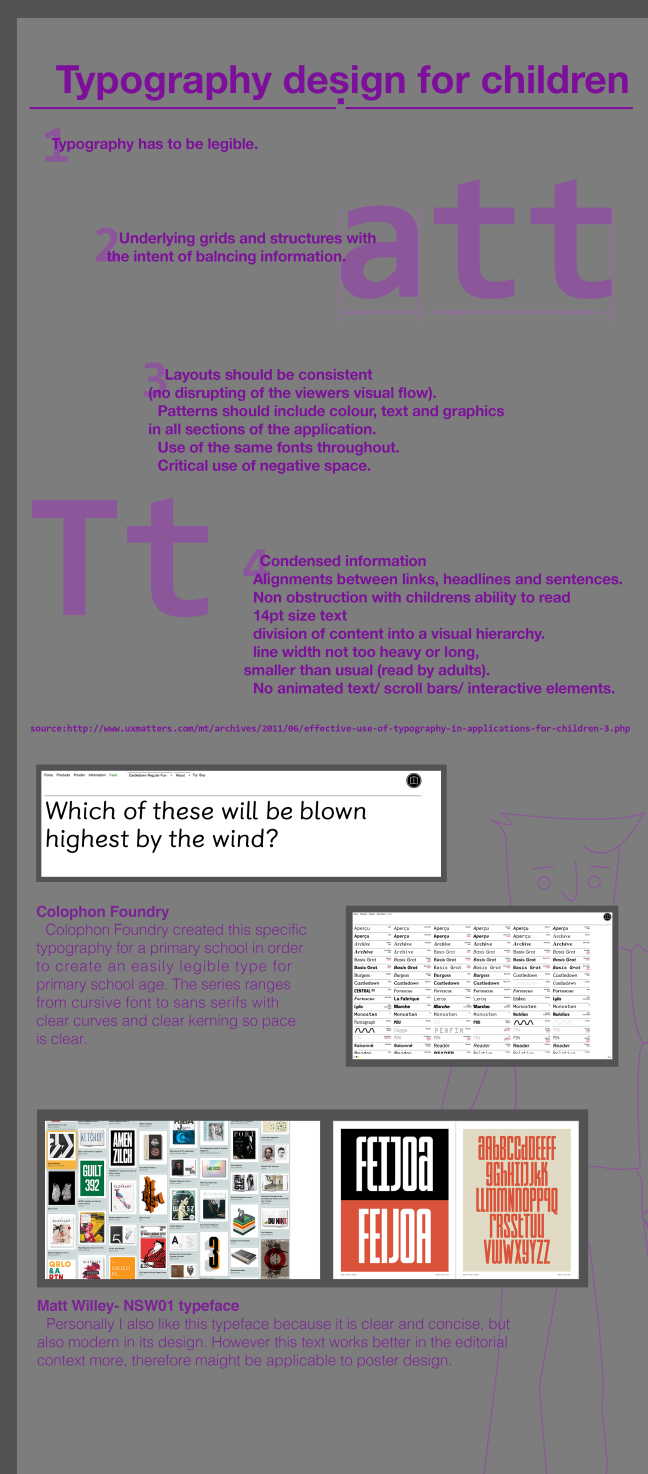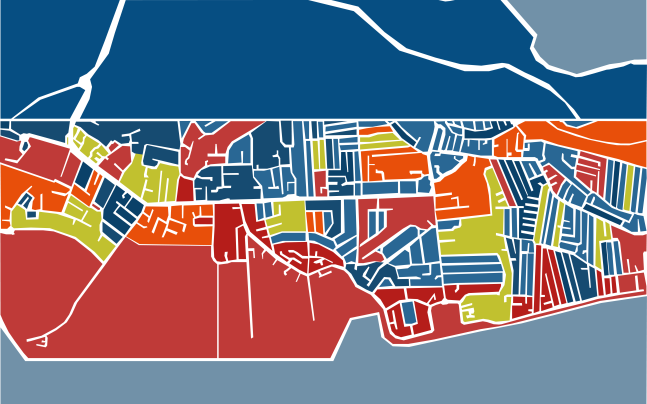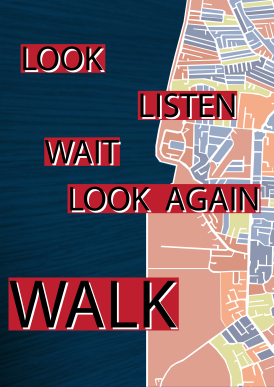
Journeys Poster series

With my original idea of providing children with new ways of learning the green cross code or the common rules of the road, I used the second project in the imminent city studio to create typographic posters that reflect the importance of waiting, looking and listening through propaganda material and through use of a pastel colour palette and mix with my map that I have created. This started after my experimentation with the Barbara Kruger technique in order to make my design look visually bold.

At first, I combined the coloured map depicted here with a pastel colour scheme, an then layered the text over the top in illustrator.
This was the initial .png file that was created as a result. I wanted to experiment with space a little and so with the next two posters I re-designed the layout
However, I still felt it lacked texture, so by taking a photo of the grain in wood on a table, I got this result:

Following this line of experimentation, I began to explore a few other techniques involving shadowing the text and playing around with broken typography.
The result looks good but I may tamper with it more once I have outlined my brief for my FMP.
FMP plan
The last post will filter somewhat into this post.
I have researched what a brief consists of in order to work backwards to make a brief myself.
<www.cleardesignuk.com/design-brief.html>
Design issues need to be considered and questioned
Is it needed?
Does it already exist?
Aims need to be set and why the creation is important
How it fits into the industry
helps clarify your thoughts and can indirectly help to find flaws
Primary, secondary and tertiary audiences.
Important keywords
Time-scale/ budget
Social network involvement
Design styles to consider
Colour, Imagery, text, typography, atmosphere
Taking atmosphere from other places i.e from a video to creat a flyer.
More design examples the better.
Leading on form this I have looked at a few ideas and examples
Text> Reading stages of children> Simple explanations
Colour> 60/30/10 ratio of colours> colourlovers.com> Pastel colours give engagement bright and visual.
Styles> Simple imagery visual bold> Simple layout and links/ steps> designing for all types of learners
Audience> Children for the most part> Adults need to help if they get stuck
Typography> Simple contours and letter spacing.
From Current research I have not found any project vaguely similar to my idea, therefore I may be in new territory. I will need to tackle this issue by looking at another example. I may need to follow the article on engineering to help solve some issues surrounding the idea of the project in terms of relevance. Or research something that expands their learning significantly at that stage.
What are kids already taught about the rules of the road?
Green Cross code.
Safety out and about
Use of seatbelt in cars
Why are these important?
Why did I want to start with this project?
-decrease the learning barriers that can affect learning to drive at a later stage and road safety.
-Increase road awareness- more mature, are about to enter secondary school, so becoming more independent.
These Questions and points need to be focused on before I start designing or creating the brief.
Planning Ahead…
I have a lot of projects to deal with at once, therefore I need to start planning effectivley on what I am doing and when. At the moment I need to focus on my FMP and how I am going to research my subject clearly in a small time frame.
In the studio Luke and Ricardo have put together some strands in which to tackle my projects with the remaining time. There are 5 stands which could lead to progression in a short amount of time: Film, Trip, Research, design and prototype. I have listed the following for my current projects and FMP:
project 1
Film- Film of the prop that would be used in the job or the helmet/ writing a letter to an employee of the company.
Trip- Imperial War Museum OR Tate Modern for propaganda material (expanding current research in both project 1 and 2)
Research- Modern Propaganda techniques and ease of communication
Design- New video stills that explain the job more (over a minute)
Prototype- Suit helmet with real world materials.
project 2
Film- Use of the zine/ use of the app prototype through Marvel
Trip- Design Museum or Museum of Modern art for insight
Research- linking into the creation of FMP brief
App- whether current experimentation can be used within the app
Prototype- App demo in marvel
FMP
Writing a brief
Stories From the Roman Road
- Bryant and May match making factoryBryant and May were Quakers in the early 1850’s. They wanted to establish merchant in the area and so bought the land to build a factory. It became one Britains largest factories and was immensely popular.
One particular story of highlight that I found was the story of the working conditions that women had to suffer in the factory. Annie Besant, a leading journalist who was advocating for better working conditions in factories, wrote an article in 1888 which stated that the factory paid over the amount it promised in dividends, whilst still providing minimal wage for the workers. There were stories of abuse by the foreman (a form of supervisor) and there were hefty fines for the workers for accidents and disobeying strict rules. Even as far as when one woman tried to save her arm caught in a machine received a dock to her wages for caring for her arm more than the machine.
Beast went on to lead the demands for better pay and rights for women in factories and
succeed in the creation of the first Women’s trade union - G.Kelly’s Eel and Pie shopG.Kelly’s was based around the premise of selling eel and pies in the early 1900’s. Originally they were sold from stalls in the streets but George Kelly’s father opened a shop in Bethnal Green after getting compensation for an injury in 1915. The store was very successful and so George went on to open his own shop whilst also owning an eel supply. The shop remained open even in WW2 after Georges Brother-in-law asked the ministry of food to allow a quota, which increased its popularity immensely. The public ate the pies with their rations which improved their happiness due to the situation they were in.
Georges Brother-in-law eventually bought the business the 50’s and became well known for the quality and cleanliness of the shop and has been running ever since to this day. - Bow Baths
Bow Baths was opened in 1892 for the public access instead of in the canal or Victoria Park lake. Housed events took place within the building such as water polo and a total of 176,000 visitors with queues reported in its later years after WW1. Heat and hot water from the baths was provided to Bow Library through its pipeline.
Most notably, Bow Baths saw rallies and speakers during its years that debated subjects such as coal miners and pay negotiations. However, Bow Baths was badly bombed in WW2 and never re-opened.






